



2J1 Recall that different technologies used in cells give different terminal voltages.
There is always a little confusion over the words "cell" and "battery".
Before you took up Amateur Radio as a hobby what you and I, and probably hundreds of others, thought of as a battery is in fact a cell. Go into a shop and ask for a single 1.5 volt battery and you will be sold a 1.5V battery but in fact what you will have bought is a single 1.5V cell.
For Amateur Radio and this course especially you need to know that it is only when two or more cells are connected in series or parallel do those cells become known as a battery.
The single cell is made up of chemicals and when its energy is used up, it has to be disposed of in an environmentally friendly way. This is called a primary cell. Typically a single cell has a voltage of around 1.5V depending on materials used in its construction. There is a secondary cell typically 1.2V which is similar and made from different chemicals which can be re-charged several times according to the manufacturer instructions.
Cells have the ability to store electrical energy in the chemicals which make up the cell, else they would be of little use in a torch!
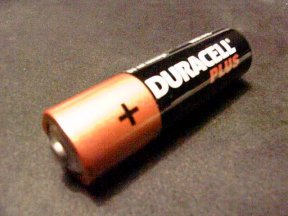

When two or more of these single cells are connected in series They form a battery.

When cells are connected in series as a battery, the total voltage is the sum of each individual cell. So six 1.5v cells in series would give a 9V battery. When cells are connected in parallel as a battery the voltage remains the same as a single cell around 1.5V. A car battery has a voltage around 12V, but why so big? It is all about the storage capacity of the battery.
Recall that battery capacity (stored energy) is measured in Ampere-hours (Ah).
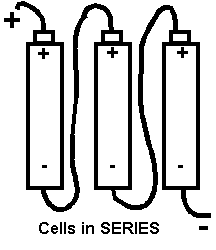
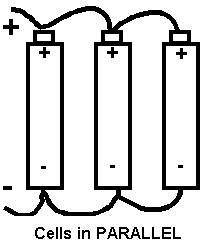
The stored energy in a battery is measured in Ampere-hours (Ah)which is the amount of energy (current)it can release into a circuit. In the case of our car battery (big) it can supply several amps for an hour or several hours at an amp when fully charged. Our small single-cells can have e.g. only 400 mAH or 400 milli-Amps for an hour. Some give more and some give less depending of their chemical components. Their voltage increases as you add more cells to make the battery. However, making a series battery the output is still 400mAH. Making a battery of parallel connected cells you can combine their output capacity, so six 400 mAH cells in parallel could produce around 2.4AH but the voltage is low around 1.5V.
2J2 Recall the circuit diagrams and characteristics of different types of rectifier and smoothing circuits (i.e. half wave, full wave and bridge).
There are several ways to obtain a dc supply from an a.c. supply using transformers and diodes. 1 transformer and 1 diode will give what we call half-wave rectification.
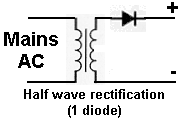
We can use a transformer with a centre-tapped secondary and two diodes. This will give us full wave rectification. The waveforms are as below in the next part.
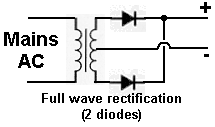
There is another way using 4 diodes or a bridge rectifier module with 4 diodes built-in.
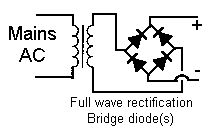
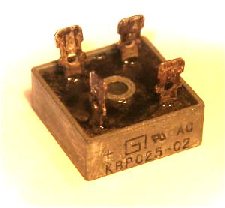
These give a rectified d.c. output which is called pulsed d.c. because it still contains some of the sine wave at the peaks. We already talked about this in our a.c. circuits theory. To overcome this problem and make the d.c. "smooth" we add a capacitor that will hold the voltage at a smooth d.c. level.
2J3 Understand that in a rectifier circuit a capacitor can store a charge during the conducting part of the cycle and release it during the non-conducting part, providing a smoothing effect and a smoother DC output.
Identify the AC and rectified (pulsed DC) waveforms.

This is the a.c. as it comes from the transformer secondary winding. Let us see what happens as it goes through our power supply. It is then acted upon by the diodes - here is the half-wave rectified current.


In order to overcome the peaks and falls in the Pulsed d.c. we add the "smoothing" capacitor.


There we have a better (smoother) level of output after the smoothing capacitor has done its work.
2J4 Identify discrete component and integrated circuit linear power supplies and understand the basic principle of their operation.
The need for stable power supplies is important in our receivers and transmitters. This is especially the case for use in VFO's, but that will come later in this self-training course. Main amateur radios need a stable supply either from battery supplies or mains supplies to protect the sensitive circuits. Even battery supplied radios can fail if the batteries run down and provide incorrect voltages.
To over come this issue, we have Voltage regulation circuits in the power supply area. Regulation must be able :-
for amateur radio use supply a fixed voltage output usually 13.8V
output must be able to detect some failure whether it is:-
over voltage
over current
The other part that is needed is some form of REGULATOR to keep the output voltage at say 13.8V all the time without any regard as to the level of current being drawn.
In its simplest form, for low current use, a regulator could be as simple as a Zener diode and a resistor in series across the DC supply. The value of the zener diode determines what the output voltage is.
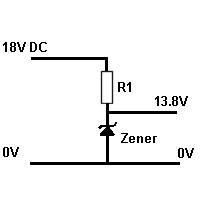
The next stage would be to add a pass transistor as shown below. Here again the zener determines the output voltage.
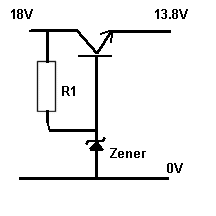
The next stage in complexity would have a regulator which consists of a few more components as shown in the diagram below as it develops. In this case it is the variable resistor as part of the potential divider chain of resistors that determines the output and thus can be "set" to the output required.
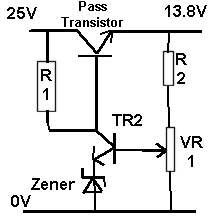
The transistor at the top is called a PASS TRANSISTOR as it is passing all the current going to the output terminal. The lower transistor is part of the regulator circuit. Please note a ZENER diode has been used at a voltage of 5.6V. Such a rated diode performs very well and can control the voltage close to 5.6V without change due to heating.
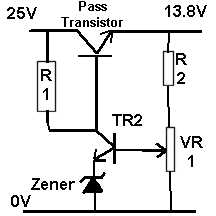
With the power turned on the preceding part of the circuit will supply 25V to the collector of the pass transistor. R1 will then supply a small current to the base of the pass transistor and current will then flow through the transistor to the output terminal where the diagram is marked 13.8V.
The 13.8V is controlled by the potential divider chain of R2 and VR1 which controls the current flowing into the base of the second transistor. If the 13.8 goes higher then more current flows into the base turning TR2 on harder. This results in there being less current available to the base of the pass transistor, hence the output falls to a point where there is equilibrium in the circuit. The zener is always conducting, providing a reference voltage against which the output voltage is compared. If the 13.8V goes lower then less current flows into the base and TR2 begins to turn off. This results in there being more current available to the base of the pass transistor, turning it on more, and the output voltage rises to the point where again there is equilibrium in the circuit.
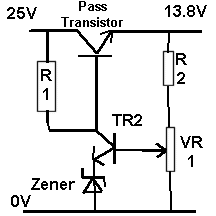
This action continues and thus regulates the output voltage and stabilizes it to 13.8V +/- a very little.
VR1 is used to set the output level at 13.8V initially.
The use of an IC
It is possible to carry out many of the above circuit functions with an IC such as LM723 which is a voltage controlling IC. Be aware that IC's can control voltage circuits of a power a supply when used in conjunction with pass transistors and other components.
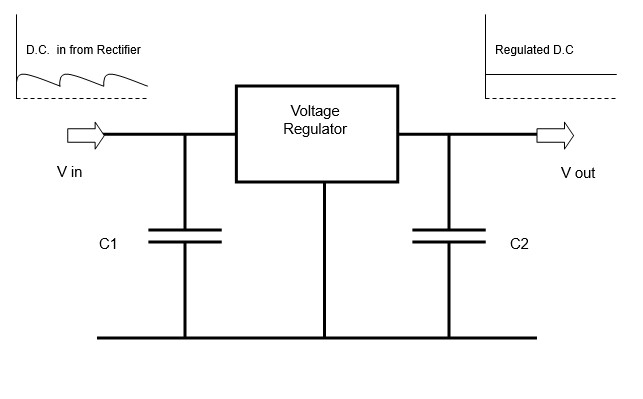
Pulsed d.c. comes to the IC regulator input which also has C1 as a smoothing capacitor. The use of the IC regulator also steps down the voltage, but has a real effect of smoothing the d.c. output to near a pure level of voltage. Capacitor C2 has a stabilising effect on the way the IC regulator works. Typical use for home constructors are the 78XX series of regulators. e.g. a 7805 would give a 5V stable output or a 7812 would give a 12V output. They can also be used with pass transistors to pass higher currents.
Recall the relative merits of linear and switched mode power supplies: size, efficiency, heat, input and output voltage, RFI, cost and weight.
A power supply with a transformer, rectifier and stabilising circuits is known as a linear power supply. It gives a mostly pure d.c. output, but the components together can be rather large and bulky for modern radios, but they are still available and used generally for high current devices suc as a transceiver.
There is a more modern type of power supply called a switched mode power supply SMPS which is more compact and works in a different way directly from a mains a.c. supply to provide our wanted regulated d.c. voltage and current.
In our Switch Mode Power Supply, the mains supply enters an "Input Filter" which takes out any spurious electrical noise which may be generated in the power supply from going back in to your mains supply in your property. Such a filter is present in a good quality switch mode power supply.
The mains AC voltage is fed into a "Rectifier Circuit" to provide High Voltage DC, and as in a traditional power supply with a transformer there will normally be a reservoir capacitor following the rectification.
The next part is a "Chop" comprising of high voltage transistors acting as switches on and off, which chops up the DC into short pulses at around 30 to 60 kHz. As these transistors are either on or off, the power dissipation is low compared to the traditional power supply switching transistors.
The pulses are then fed into a "Transformer" which converts the high voltage pulses to pulses of the required voltage, which it passes to the next stage. As the transformer is dealing with relatively high frequencies compared to the usual 50Hz supply, the transformer in a Switch Mode Power Supply can be much reduced in size. Also the Transformer has a Ferrite Core and not a Soft Iron so that the core does not become "saturated" and stop working. The winding of the transformer are also well insulated.
After the Transformer stage is another "Rectifying Circuit" which converts the High Voltage DC to Low Voltage DC. The regulation of the DC pulses to the required voltage is achieved by looking at (or in electrical terms "Sampling") the output voltage of the pulses, and comparing the pulses via an opto-isolator (also know as an opto-coupler), to control "The CHOP" of the pulses' width on the primary side of the transformer.
A smoothing capacity will exist after the second rectification block diagram and this capacitor can be much smaller than in the conventional power supply because it is working at higher frequency of about 50kHz.
Making sure the OUTPUT voltage is as required there is a feed back circuit through an opto coupler which acts to isolate the signal but passes the pulse width to the primary side of the transformer.
Whilst the whole unit is much smaller than the conventional power supply it does have a down side, it can create harmonics due to the switching.
There must be an "Input filter" to stop the harmonics leaking into the mains supply and another "Output Filter" ensures that no harmonics go into the low voltage supply to your equipment. Such filters are present in a good quality switch mode power supply. Failure to have good filtering and screening can create high background RF noise which would be picked up on your radio receiver.
Here is a picture of a typical Switch Mode Power Supply
